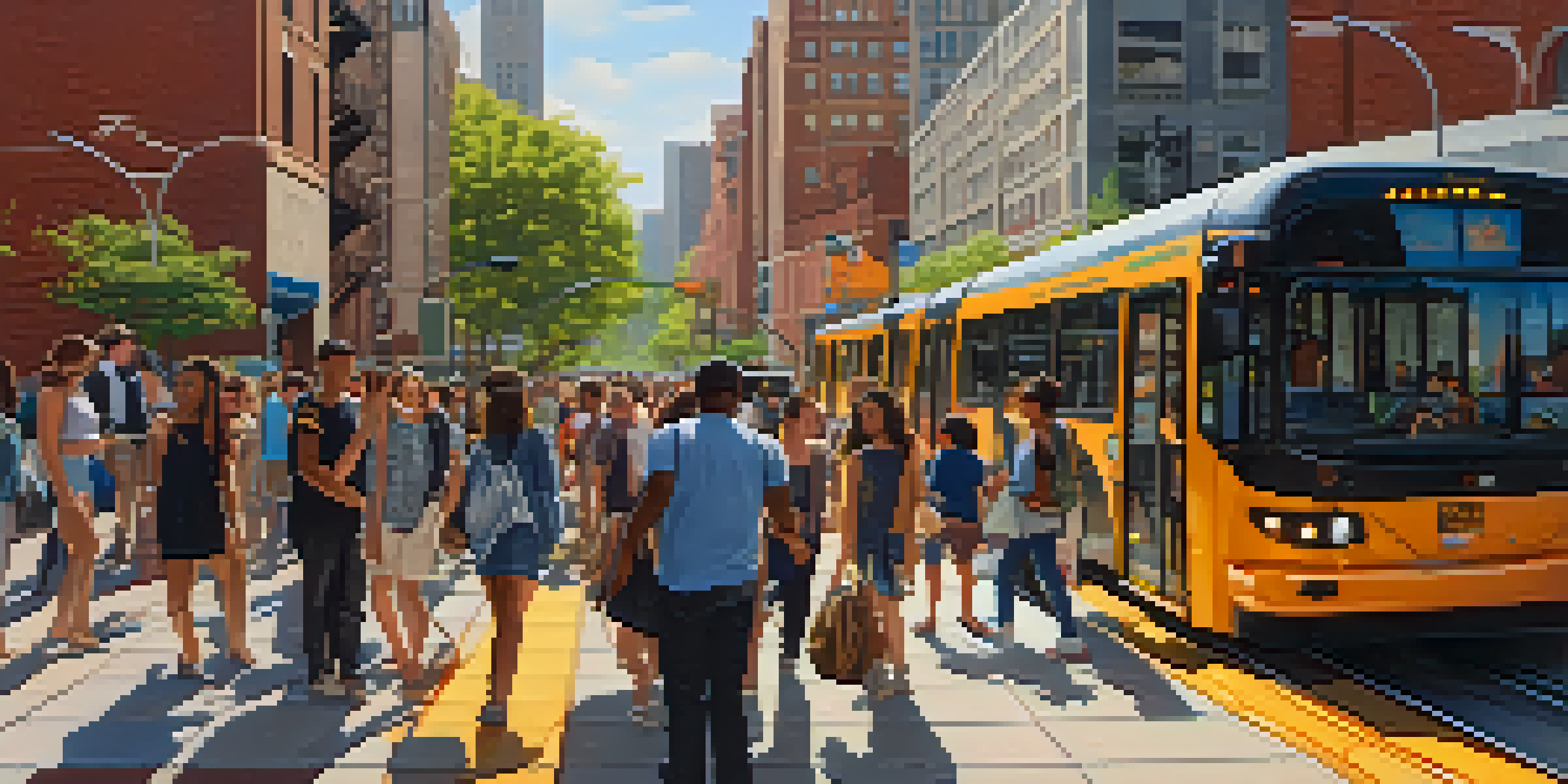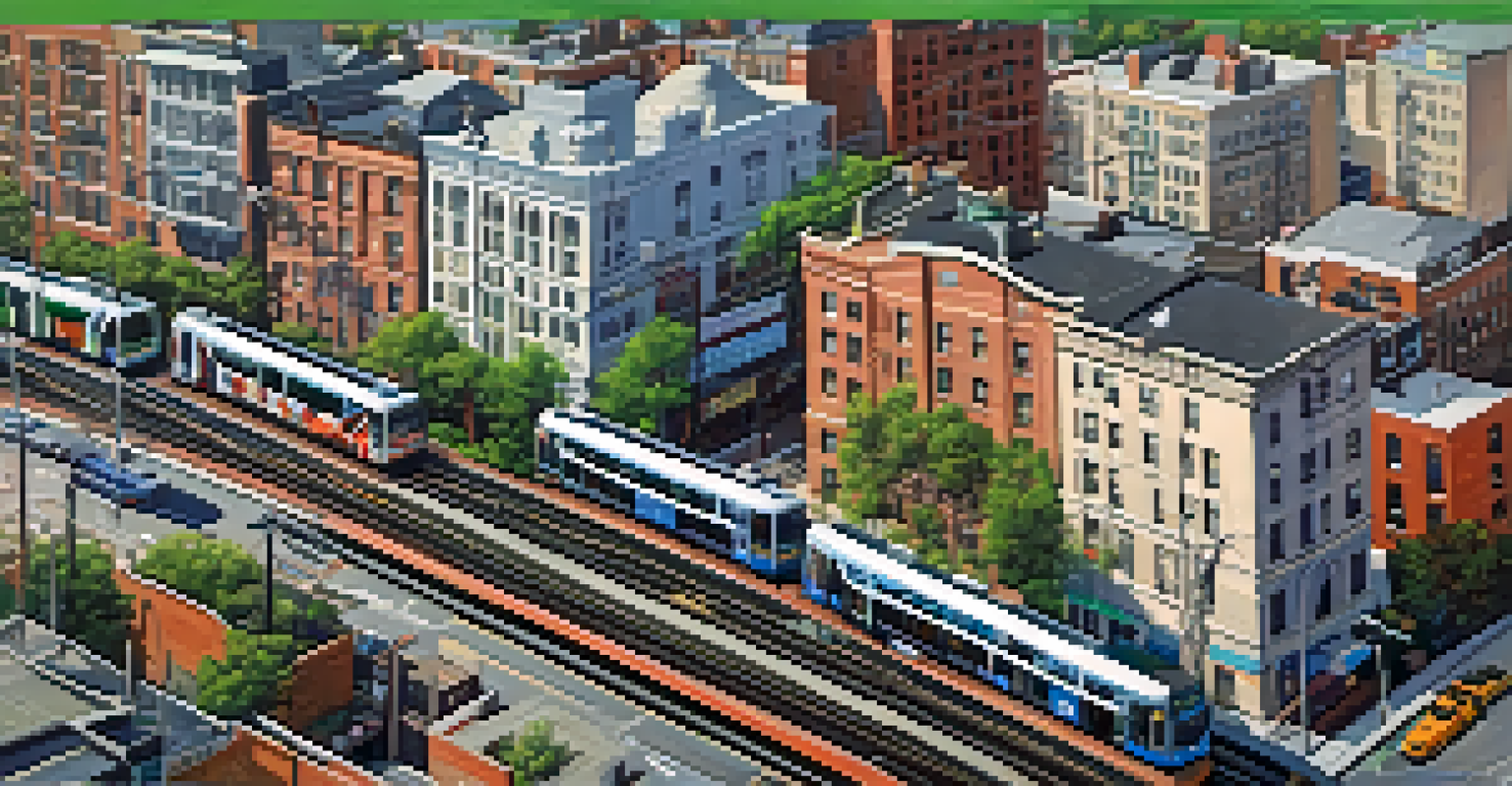Public Transportation Improvements in Jersey City

The Need for Improved Public Transportation in Jersey City
Jersey City, known for its vibrant culture and growing population, has faced increasing pressure on its public transportation system. With more residents commuting to Manhattan and other neighboring areas, the demand for reliable transit options has never been higher. This need has sparked discussions about the importance of modernizing and expanding the city's public transport infrastructure.
Public transportation is the backbone of a vibrant city, providing residents with access to opportunities and fostering economic growth.
A well-functioning public transportation system not only alleviates road congestion but also enhances the overall quality of life for residents. It provides an affordable and accessible way for individuals to get to work, school, and leisure activities. As a result, improving public transportation has become a priority for local government and community leaders.
Moreover, with sustainability becoming a focal point in urban planning, enhancing public transit can significantly reduce the city's carbon footprint. By encouraging more people to utilize buses and trains, Jersey City can move towards a greener future, making public transportation improvements essential for both residents and the environment.
Recent Upgrades to Jersey City's Transit System
In recent years, Jersey City has seen substantial upgrades to its public transportation infrastructure. The introduction of new buses with modern amenities and eco-friendly features has made commuting more comfortable and efficient. These upgrades not only enhance the travel experience but also align with the city’s commitment to sustainability.

Additionally, the expansion of light rail services has significantly improved connectivity within the city and to surrounding areas. This extended service means residents can reach popular destinations with greater ease, reducing reliance on cars and promoting public transit use. Such developments are crucial for accommodating the growing population and addressing their commuting needs.
Need for Better Transit Options
Jersey City's growing population demands improved public transportation to alleviate congestion and enhance quality of life.
Furthermore, the implementation of real-time tracking technology on buses and trains allows commuters to plan their journeys more effectively. Passengers can now access mobile apps to check schedules and receive updates, which enhances the overall efficiency of the transit system. These technological advancements are vital in making public transportation a more attractive option.
Community Involvement in Transportation Planning
Public participation has played a significant role in shaping Jersey City's transportation improvements. Community forums and surveys have provided residents with a platform to voice their opinions and suggest changes. This collaborative approach ensures that the transit system meets the needs of those who use it daily.
The best way to enhance a city’s livability is to create a comprehensive public transportation system that connects people to where they need to go.
Moreover, local organizations and advocacy groups have been instrumental in pushing for better transportation options. By raising awareness about transit issues and mobilizing community support, these groups have successfully influenced policy decisions. Their ongoing efforts demonstrate the power of collective action in driving public improvements.
Engaging the community also fosters a sense of ownership and pride in the transportation system. When residents feel involved in planning and decision-making processes, they are more likely to support and utilize public transit. This involvement ultimately leads to a more robust and user-friendly transportation network.
The Impact of Public Transit on Local Economy
Improving public transportation in Jersey City has far-reaching implications for the local economy. Enhanced transit options attract businesses and encourage local investments, as companies recognize the value of easy access for employees and customers. This can lead to job creation and economic growth in the area.
Furthermore, a reliable public transportation system can increase property values. As more residents seek homes near transit hubs, demand for housing in these areas rises. This not only benefits homeowners but also generates additional tax revenue for the city, which can be reinvested into community services and infrastructure.
Community Shapes Transit Planning
Public participation and local advocacy are crucial in ensuring that transportation improvements meet the needs of residents.
Moreover, improved public transit encourages tourism, as visitors can easily navigate the city’s attractions. By making it easier for tourists to travel, Jersey City can enhance its appeal as a destination, leading to increased spending in local shops and restaurants. This cycle of growth is essential for a thriving urban environment.
Challenges Facing Public Transportation Enhancements
Despite the progress made, Jersey City’s public transportation improvements face several challenges. Funding is often a significant hurdle, as securing financial resources for infrastructure projects can be complicated. Local governments may need to explore various funding sources, including state and federal grants, to support these initiatives.
Additionally, the integration of different transit modes can be complex. Ensuring seamless connections between buses, trains, and other forms of transportation requires careful planning and coordination. This complexity can lead to delays in project implementation and may frustrate commuters seeking efficient travel options.
Another challenge is addressing the diverse needs of the community. With a broad range of demographics, city planners must consider the varying requirements of residents, from students to seniors. Balancing these needs while implementing improvements can be a daunting task, but it is essential for creating an inclusive public transportation system.
Future Vision for Public Transportation in Jersey City
Looking ahead, Jersey City's vision for public transportation includes a focus on further expansion and modernization. Plans may involve increasing the frequency of services, adding new routes, and incorporating cutting-edge technologies. Such advancements will ensure that the transit system keeps pace with the city’s growth and evolving commuter demands.
Additionally, there is a strong emphasis on sustainability in future transportation initiatives. As the city aims to reduce its environmental impact, investments in electric buses and energy-efficient transit options are likely to be prioritized. This commitment to sustainability not only benefits the environment but also positions Jersey City as a leader in eco-friendly urban development.
Economic Benefits of Transit Upgrades
Enhancing public transportation can attract businesses, increase property values, and boost tourism in Jersey City.
Public involvement will continue to play a vital role in shaping the future of transportation. By encouraging ongoing dialogue and engagement with residents, city officials can ensure that improvements reflect the community's needs and aspirations. This collaborative approach is key to creating a resilient and effective public transportation system.
Success Stories from Other Cities
Jersey City can draw inspiration from other urban areas that have successfully upgraded their public transportation systems. Cities like Seattle and Portland have implemented innovative transit solutions that could serve as models for Jersey City's own improvements. Their focus on community engagement and sustainable practices has resulted in increased ridership and overall satisfaction.
For instance, Seattle's investment in light rail and bus rapid transit has transformed its transportation landscape, making it easier for residents to navigate the city. By prioritizing connectivity and accessibility, Seattle has seen significant boosts in both local economy and quality of life. These examples demonstrate the potential benefits of a well-planned public transit system.

Moreover, lessons learned from the successes and challenges faced by these cities can inform Jersey City's strategy moving forward. By analyzing what has worked in other locations, city planners can tailor their approaches to meet the unique needs of Jersey City. This adaptability is essential in creating a transportation system that truly serves its community.